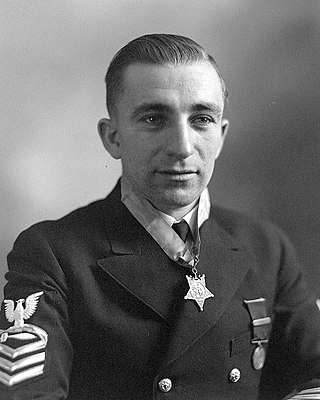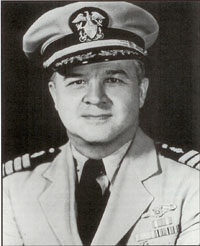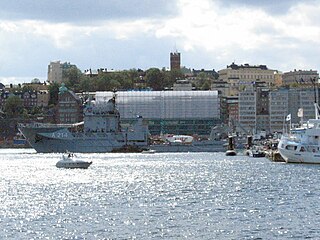
The McCann Submarine Rescue Chamber is a device for rescuing submariners from a submarine that is unable to surface.

The McCann Submarine Rescue Chamber is a device for rescuing submariners from a submarine that is unable to surface.
During the first two decades of the United States Navy Submarine Force, there were several accidents in which Navy submarines sank with the loss of life. The impetus for the invention for the chamber was the loss of S-51 on 25 September 1925 and the loss of S-4 on 17 December 1927. In the case of S-4, all of her officers and men were able to reach non-flooded compartments as the submarine bottomed in 110 ft (34 m) of water. However, the majority soon succumbed. In her forward torpedo room, six men remained alive. Heroic efforts were made to rescue these six, who had exchanged a series of signals with divers by tapping on the hull. In extremely cold water and tangled wreckage, Navy divers worked to rescue them, but a storm forced a stop to this effort on 24 December. Forty men lost their lives.
These experiences led submariner Charles B. "Swede" Momsen to think of technical alternatives for rescuing survivors from sunken submarines, which at that time was still a virtual impossibility. Momsen soon conceived a submarine rescue chamber that could be lowered from the surface to mate with a submarine's escape hatch and proposed the concept through official channels. [1] While in command of the submarine S-1 (SS-105), in 1926, Momsen wrote the Bureau of Construction and Repair (BuC&R) recommending the adoption of a diving bell for the purposes of rescuing entrapped personnel from submarines. But this idea was pigeonholed by the bureaucracy, even during his own subsequent assignment at BuC&R. [2] The loss of S-4 with all hands put the Navy very much "on the spot" because of the loss of lives that might have been saved. The pressure of this incident forced favorable action and Momsen, using the aircraft hangar from S-1, designed and built a prototype submarine rescue chamber.

During the first three months of 1928, divers and other salvage personnel were able to raise S-4 and tow her to the Boston Navy Yard, where she was drydocked and repaired. She returned to active duty in October 1928 and was employed thereafter as a submarine rescue and salvage test ship. Momsen went to sea in the reconditioned S-4 to carry out practical experiments and training with the rescue chambers.
Work with S-4 helped to develop equipment and techniques that bore fruit a decade later, when 33 men were brought up alive from the sunken submarine Squalus. The first diving bells for rescuing men from submarines were designed by the BuC&R in 1928. The diving bell went through a series of tests off the shores of Key West, Florida. Based on these tests, Momsen had several changes in mind for the bell, and after nearly two years of experimentation full of highly interesting results, the final bell was evolved and christened a "rescue chamber." This success was catalyst for gaining approval for development of the submarine rescue chamber in 1930. Before he could make these changes, Momsen went to the Bureau of Construction and Repair to work on an underwater breathing apparatus (the "Momsen Lung") for individual escapes. [3]
Lieutenant Commander Allan Rockwell McCann was put in charge of the revisions on the diving bell. From July 1929 to July 1931, McCann was assigned to the Maintenance Division, Bureau of Construction and Repair, where he developed the submarine rescue chamber. When the bell was completed in late 1930, it was produced as the McCann Submarine Rescue Chamber (SRC) (Navy designated the first 12 of these as [YRC] 1–12, YRC-4 was lost aboard the USS Pigeon, at Bataan, Philippines, during the first days of WWII. YRC-5 was aboard the USS Widgeon during the attack on Pearl Harbor). In 1931, a one-fifth scale model of a diving bell for submarine rescue work was built and tested. Design called for the bell to withstand the external pressure encountered at a depth of at least 300 ft (91 m) of water, and the test showed the model fulfilled this requirement with a factor of safety of about 3.5. The vessel was tested under external pressure, failure occurring in the shell at a pressure of 470 psi (3,200 kPa ). Since the head of the vessel remained intact, it was decided to make a test of the head itself in order to determine its strength relative to that of the shell, and if possible to obtain some measure of the stresses occurring under load. The head collapsed at a pressure of 525 psi (3,620 kPa), indicating its strength under external pressure was about 10% in excess of that of the shell.
The revised Submarine Rescue Chamber had improvements including a soft seal gasket for sealing the submarine/bell interface skirting, and a floor installed to maintain air-space in the bell during raising and lowering. Momsen in his speech to the Harvard Engineering Society on 6 October 1939 credited Allan Rockwell McCann with the improvements which made the bell operational, safe and large enough to hold up to eight rescued crewmen and two operators. [4]
In 1939, the McCann Rescue Chamber made its debut when it was used to successfully rescue thirty-three survivors from Squalus, At the time of Squalus' accident, Lieutenant Commander Momsen was serving as head of the Experimental Diving Unit at the Washington Navy Yard. The submarine rescue ship USS Falcon (ASR-2), commanded by Lieutenant George A. Sharp, was on site within twenty-four hours. It lowered the Rescue Chamber — a revised version of a diving bell invented by Momsen — and, in four dives over the next 13 hours, recovered all 33 survivors in the first deep submarine rescue ever. McCann was in charge of Chamber operations, with Momsen commanding the divers. [5] Although there was no reason to believe anyone was alive in the aft part of the ship, a fifth dive was made to the aft torpedo room hatch on May 25. This run confirmed the flooding of the entire aft portion of the ship.

The rescue chamber was a pear shaped steel chamber, the big end uppermost, seven feet at the greatest diameter and ten feet high. It is divided into an upper closed compartment and a lower open compartment by a horizontal bulkhead which has a water tight hatch in its middle. Surrounding the lower compartment is a ballast tank of a capacity just equal to that of the lower compartment. Inside the lower compartment is a reel with 400 ft (120 m) of .5 in (13 mm) steel wire on it. The reel is operated by a shaft leading into the upper compartment. The shaft is rotated by an air motor. On the bottom edge of the lower compartment a rubber gasket is embedded into a circular groove, so that when the chamber is brought into contact with a flat surface (the hatch ring) a water tight joint may be effected with the application of pressure. Attached to the upper compartment is an air supply and an atmospheric exhaust hose, wire wound for strength. Also electric cables for telephone and light are attached. A wire pendant for hoisting and lowering is shackled into a pad-eye on top. This wire is also used for retrieving the chamber in case of emergency. The forward and aft hatches of American submarines were fitted for attaching the rescue chamber. They have a flat doughnut shaped plate welded to the hatch coaming upon which the bottom of the chamber rests and a bail over the center of the hatch to which the haul down wire must be attached by the diver. [6]
The McCann bell suffers severe limitations in strong currents and when dealing with a pressurized submarine or one lying at extreme angles. It is also incapable of functioning below 850 ft (260 m). The USN Submarine Rescue Chamber (YRC) is air transportable to a Vessel Of Opportunity (VOO) Mother Ship (MOSHIP) which requires little modification to use the system. Transfer Under Pressure (TUP) to and from pressurized environments such as submarines or hyperbaric chambers is not possible with this system, even though TUP is essential where being subjected to ambient pressure may be life-threatening. Since the creation of the Deep Submergence Rescue Vehicles Mystic and Avalon, the McCann Rescue Chamber is rarely used, but is part of the Submarine Rescue Chamber Flyaway System (SRCFS) which is capable of worldwide submarine rescue missions. Once launched, the SRCFS is able to operate around the clock.

USS Sailfish (SS-192), was a US Sargo-class submarine, originally named Squalus. As Squalus, the submarine sank off the coast of New Hampshire during test dives on 23 May 1939. The sinking drowned 26 crew members, but an ensuing rescue operation, using the McCann Rescue Chamber for the first time, saved the lives of the remaining 33 aboard. Squalus was salvaged in late 1939 and recommissioned as Sailfish in May 1940.
BAP Pacocha (SS-48) was a submarine of the Marina de Guerra del Perú named for the 1877 Battle of Pacocha, in which the Peruvian ironclad Huascar clashed with the Royal Navy. Formerly USS Atule (SS-403), a Balao-class submarine with a GUPPY IA upgrade, she had been sold to Peru and commissioned on 28 May 1974. She was rammed and sunk by a fishing trawler on 26 August 1988.

Charles Bowers Momsen, nicknamed "Swede", was born in Flushing, New York. He was an American pioneer in submarine rescue for the United States Navy, and he invented the underwater escape device later called the "Momsen lung", for which he received the Navy Distinguished Service Medal in 1929. In May 1939, Momsen directed the rescue of the crew of Squalus (SS-192).

HMS Thetis (N25) was a Group 1 T-class submarine of the Royal Navy which sank during sea trials in Liverpool Bay, England on 1 June 1939. After being salvaged and repaired, the boat was recommissioned as HMS Thunderbolt in 1940. It served during the Second World War until being lost with all hands in the Mediterranean on 14 March 1943.

A diving chamber is a vessel for human occupation, which may have an entrance that can be sealed to hold an internal pressure significantly higher than ambient pressure, a pressurised gas system to control the internal pressure, and a supply of breathing gas for the occupants.

A deep-submergence rescue vehicle (DSRV) is a type of deep-submergence vehicle used for rescue of downed submarines and clandestine missions. While DSRV is the term most often used by the United States Navy, other nations have different designations for their vehicles.

A United States Navy diver refers to a service personnel that may be a restricted fleet line officer, civil engineer corps (CEC) officer, Medical Corps officer, or an enlisted who is qualified in underwater diving and salvage. Navy divers serve with fleet diving detachments and in research and development. Some of the mission areas of the Navy diver include: marine salvage, harbor clearance, underwater ship husbandry and repair, submarine rescue, saturation diving, experimental diving, underwater construction and welding, as well as serving as technical experts to the Navy SEALs, Marine Corps, and Navy EOD diving commands.

The third USS Pigeon (ASR–21) was the lead ship of her class of submarine rescue ships. Laid down on 17 July 1968 by the Alabama Dry Dock and Shipbuilding Co., Mobile, Alabama, the ship was launched on 13 August 1969, sponsored by Mrs. Allen M. Shinn, wife of Vice Admiral Shinn, Commander Naval Air Force, U.S. Pacific Fleet, and commissioned on 28 April 1973. She was a sister ship to USS Ortolan (ASR-22).

John Mihalowski was a United States Navy diver and a recipient of America's highest military decoration—the Medal of Honor.

The third USS Falcon, (AM-28/ASR-2) was a Lapwing-class minesweeper in the United States Navy. She later became a submarine rescue ship.

Vice Admiral Allan Rockwell McCann, was a United States Navy officer who served in World War I and World War II. His US Navy Serial number was 10829.
Rear Admiral Oliver Francis Naquin, United States Navy was born in New Orleans, and was a 1925 graduate of the United States Naval Academy. He was one of 33 men rescued by the McCann Rescue Chamber when the submarine USS Squalus sank in 240 feet of water during routine sea trials in the Atlantic Ocean off Portsmouth, New Hampshire on May 23, 1939, and was rescued in a two-day rescue operation.

The United States Navy Experimental Diving Unit is the primary source of diving and hyperbaric operational guidance for the US Navy. It is located within the Naval Support Activity Panama City in Panama City Beach, Bay County, Florida.

A submarine rescue ship is a surface support ship for submarine rescue and deep-sea salvage operations. Methods employed include the McCann Rescue Chamber, deep-submergence rescue vehicles (DSRV's) and diving operations.

Captain Albert Richard Behnke Jr. USN (ret.) was an American physician, who was principally responsible for developing the U.S. Naval Medical Research Institute. Behnke separated the symptoms of Arterial Gas Embolism (AGE) from those of decompression sickness and suggested the use of oxygen in recompression therapy.

Captain Charles Wesley Shilling was an American physician who was known as a leader in the field of undersea and hyperbaric medicine, research, and education. Shilling was widely recognized as an expert on deep sea diving, naval medicine, radiation biology, and submarine capabilities. In 1939, he was Senior Medical Officer in the rescue of the submarine U.S.S. Squalus.
The People's Republic of China developed a class of 35-ton deep-submergence rescue vehicle (DSRV) for the People's Liberation Army Navy (PLAN). It was first tested in 1986 and operational in 1989.
The Royal Swedish Navy's Submarine Escape and Rescue system (SMER) is a set of equipment used by the Swedish Navy to provide rescue facilities for the crews of disables submarines. The submarine rescue ship, the submarine rescue vessel, and the escape system on the submarines, which consists of an escape trunk and an escape suit, are its three main parts.

URF is the Royal Swedish Navy’s Submarine Rescue Vessel.
Submarine rescue is the process of locating a sunk submarine with survivors on board, and bringing the survivors to safety. This may be done by recovering the vessel to the surface first, or by transferring the trapped personnel to a rescue bell or deep-submergence rescue vehicle to bring them to the surface. Submarine rescue may be done at pressures between ambient at depth, and sea level atmospheric pressure, depending on the condition of the distressed vessel and the equipment used for the rescue. Self-rescue of submarine personnel by buoyant free ascent at ambient pressure is considered submarine escape. Survivors may require recompression treatment for decompression illness.
{{cite web}}: CS1 maint: archived copy as title (link)